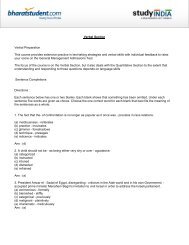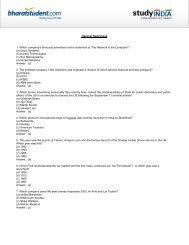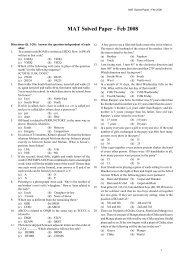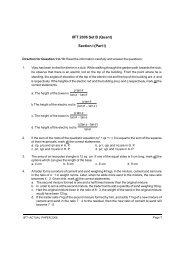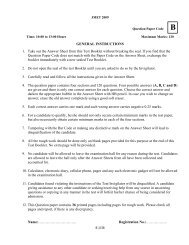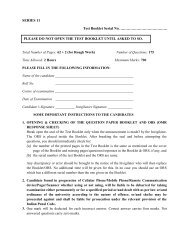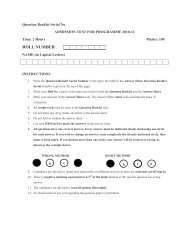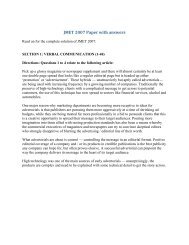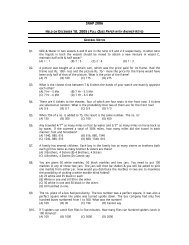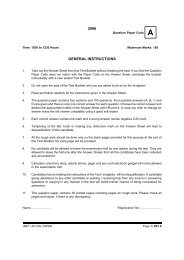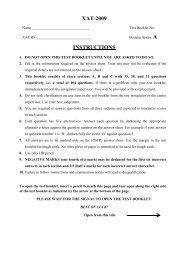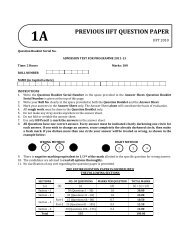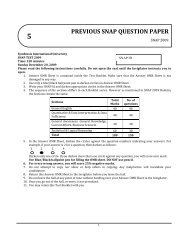PREVIOUS FMS QUESTION PAPER
PREVIOUS FMS QUESTION PAPER
PREVIOUS FMS QUESTION PAPER
You also want an ePaper? Increase the reach of your titles
YUMPU automatically turns print PDFs into web optimized ePapers that Google loves.
101. The sum of all the roots of 4x 3 – 8x 2 – 63x – 9 = 0 is:<br />
(1) 8 (2) 2 (3) – 8 (4) –2<br />
102. A man born in the first half of the nineteenth<br />
century was x years old in the year x 2 . He was born<br />
in:<br />
(1) 1806 (2) 1836 (3) 1812 (4) 1825<br />
103. A train, an hour after starting, meets with an<br />
accident which detains it for a half hour, after<br />
which it proceeds at 3/4 of its former rate and<br />
arrives 3(1/2) hours late. Had the accident<br />
happened 90 kilometers farther along the line, it<br />
would have arrived only 3 hour late. The length of<br />
the trip in kilometers was:<br />
(1) 400 (2) 465 (3) 600 (4) 640<br />
104. The times between 7 and 8 o’clock, correct to the<br />
nearest minute, when the hands of a clock will<br />
form an angle of 84 degrees are:<br />
(1) 7: 23 and 7: 53 (2) 7: 20 and 7: 50<br />
(3) 7: 22 and 7: 53 (4) 7: 23 and 7: 52<br />
105. √ √<br />
(1) x = 1 (2) x = 2<br />
(3) x = 2/3 (4) x = 2, x = 1<br />
106. If log x – 5 log 3 = –2, then x equals:<br />
(1) 1.25 (2) 0.81 (3) 2.43 (4) 0.8<br />
107. Three boys agree to divide a bag of marbles in the<br />
following manner. The first boy takes one more<br />
than half the marbles. The second takes a third of<br />
the number remaining. The third boy finds that he<br />
is left with twice as many marbles as the second<br />
boy. The original number of marbles:<br />
(1) is 8 or 38<br />
(2) cannot be determined from the given data<br />
(3) is 20 or 26<br />
(4) is 14 or 32<br />
SECTION-III<br />
Quantitative Ability (50 questions)<br />
PP-02 2A.20<br />
<strong>FMS</strong> Dec 2010<br />
108. A three-digit number has, from left to right, the<br />
digits h, t, and u with h > u When the number with<br />
the digits reversed is subtracted from the original<br />
number, the units’ digit in the difference is 4. The<br />
next two digits, from right to left, are:<br />
(1) 5 and 9 (2) 9 and 5<br />
(3) 5 and 4 (4) 4 and 5<br />
109. In a group of cows and chickens, the number of legs<br />
was 14 more than twice the number of heads. The<br />
number of cows was:<br />
(1) 5 (2) 7 (3) 10 (4) 12<br />
[√√<br />
]<br />
[√√<br />
(1) α 16 (2) α 12 (3) α 8 (4) α 4<br />
( ) √ ( )<br />
√<br />
( ) √ ( ) √<br />
112. Given two positive integers x and y with x < y The<br />
percent that x is less than y is:<br />
( )<br />
( )<br />
( )<br />
( )<br />
( )<br />
]<br />
√<br />
( )<br />
( ) ( )<br />
113. The points A, B and C are on circle O. The tangent<br />
line at A and the secant BC intersect at P, B lying<br />
between C and P. √<br />
(1) 5 (2) 10 ( ) √ (4) 20<br />
114. The sum of three numbers is 98. The ratio of the<br />
first to the second is 2/3, and the ratio of the<br />
second to the third is 5/8. The second number is:<br />
(1) 15 (2) 20 (3) 30 (4) 32



